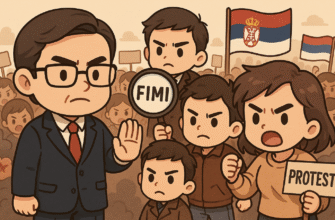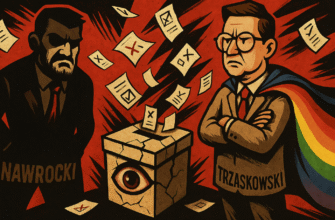The presidential elections in Romania on May 18, 2025, became a historic event, ending with the victory of the pro-European, democratic candidate Nicusor Dan, who received 54% of the votes against 46% for the nationalist candidate George Simion. This campaign actively unfolded on social media, especially on TikTok, where both candidates waged a fierce battle for voters’ attention. The previous Georgescu case demonstrated the effectiveness of TikTok as a political communication tool, and Simion largely built his strategy on this experience, using similar tactics and nationalist rhetoric. Simion actively supported Georgescu, who was disqualified from participating in the elections in March 2025, and became the standard-bearer of right-wing forces. In this analysis, we will examine how the two candidates used TikTok in the second, decisive phase of the election campaign, and evaluate the effectiveness of their strategies.
Political hashtags in TikTok trends led on the day of the second round of presidential elections (May 18, 2025):

The presented table of trends in the Romanian segment of TikTok shows key hashtags by popularity. The hashtag #romania takes the first position with impressive 194.8B views and 8.1M videos, demonstrating a high level of patriotic content. Notably, political hashtags of candidates are also in the top: #nicusordan (1.3B views) and #georgesimion (2.2B views). Interestingly, with fewer views, the hashtag #nicusordan shows a higher level of engagement (5.3 versus 4.7 for Simion), which may indicate better quality interaction of the audience with his content. The hashtag #foryoupage remains the most used non-profile tag with 811.7B views, which is typical for TikTok and serves to increase organic reach.
Based on data from Exolyt — TikTok Social Intelligence Platform
This time, unlike the previous publication: Political hashtags in Romanian TikTok trends we decided to focus only on two hashtags and two accounts of presidential candidates in Romania.
Study period: May 4 – May 18, 2025
This graph shows the number of posts with candidate hashtags and how many views they collected during the last two weeks of the final election campaign:

The activity graph of Romanian candidates for the period from May 1 to May 19, 2025, clearly demonstrates the dynamics of their presence on TikTok. George Simion has a significantly higher number of videos (red columns) compared to Nicusor Dan, however, Dan’s views (blue line) show a sharp increase towards the end of the period, reaching a peak on May 18 — election day. Maximum viewing rates reach 81 million for Simion and 75 million for Dan. Interestingly, despite fewer videos, Dan’s content received more views on average, as evidenced by the efficiency ratio of 1.62 in his favor. This may indicate better quality and more relevant content that resonates with the audience.
Let’s analyze the presidential candidates’ hashtags according to the previous scheme:
#georgesimion

Visualization of the #georgesimion hashtag network shows an extensive ecosystem of related tags. The central position is occupied by the hashtag #georgesimion itself (marked with a red circle), surrounded by clusters of thematically related tags. Large clusters of general Romanian themes (blue), party hashtags (yellow), and specific political topics (green and purple) are noticeable. Notably strong intersections with hashtags #romania, #aur (Simion’s party), and #calingeorgescu, which confirms the continuity of Simion’s campaign from the previously withdrawn Georgescu. Visually, it can be determined that the hashtag #georgesimion has a branched network of connections, indicating a well-organized campaign covering various segments of political discourse in Romanian TikTok.
Let’s show the ten largest hashtag intersections with this one:

During the study period, an impressive amount of content was identified — 17541 videos with the hashtag #georgesimion. This indicates a large-scale campaign implemented by both the candidate’s official channels and supporters. The distribution graph shows that the peak of publications occurred in the last days before the election, which is typical for election campaigns and reflects the strategy of maximum mobilization of the electorate at the crucial moment. This volume of content significantly exceeds the indicators of other candidates, which may indicate greater organization of Simion’s team or possible use of coordinated content creation networks.
Top 30 accounts with maximum views:
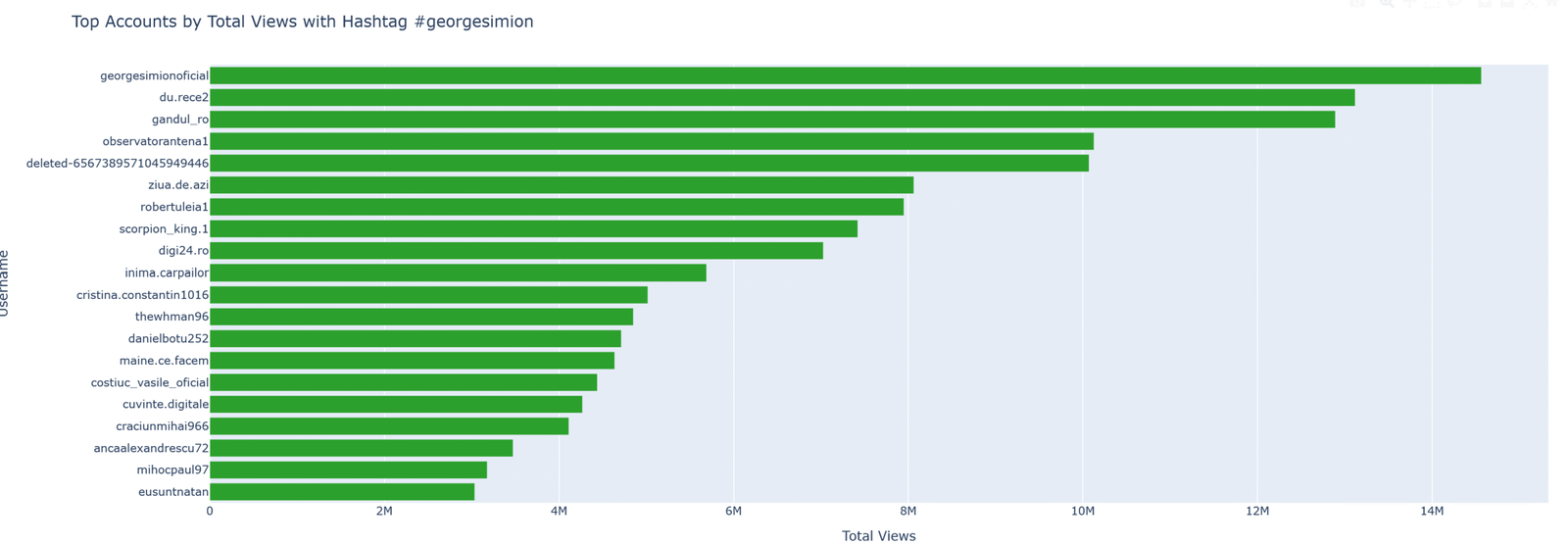
The graph of the top 30 accounts by number of views for the hashtag #georgesimion demonstrates clear leaders. The first positions are occupied by the candidate’s official account (georgesimionficial) and major supporting channels such as din.cmpulung and vremuri.noi. There is a noticeable uneven distribution of views — the first 5 accounts collect a disproportionately large share of attention, which is characteristic of centralized campaigns. It is interesting to note that the top includes both official accounts and, probably, third-party supporting channels, which may indicate a combined strategy of official and “organic” support. The high concentration of views among several accounts can be both a sign of an effective strategy and a possible indicator of artificial inflation.
Top 30 accounts with maximum posts:
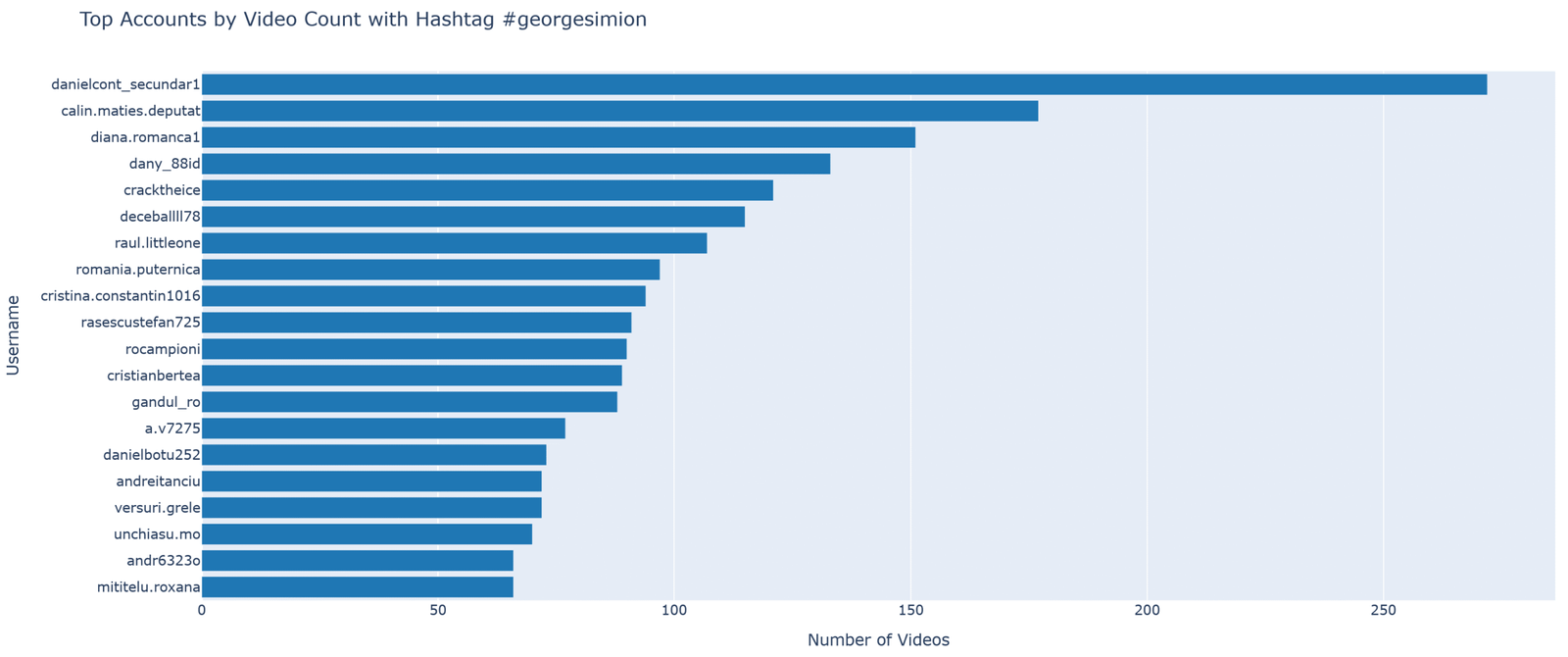
Analysis of the top 30 accounts by number of posts with the hashtag #georgesimion reveals the main content creators supporting the candidate. The leader is patriotalromaniei2025 with more than 250 videos, followed by calin.matties.degeaba and diana.rompati43 with approximately 150-180 videos each. Notably, the candidate’s official account is not in the top 5 in terms of publications, indicating a significant role of supporters in content creation. The distribution is more uniform than by views, which indicates a decentralized network of content creators. Also noticeable is the presence of accounts associated with Calin Georgescu, which confirms the continuity of strategies and audience between candidates.
Views to likes ratio for top accounts:

/* The dot size depends on the number of posts.
The views to likes ratio graph for top accounts of the hashtag #georgesimion reveals interesting patterns. The dot size on the graph reflects the number of posts, and the color reflects the total number of likes. Several suspicious outliers are observed, especially for the georgesimionficial account, which has a disproportionately high number of likes for high views. Most accounts demonstrate typical engagement metrics (usually 5-15% likes from views), but some channels show abnormally high values exceeding 20-30%, which may indicate artificial increase in engagement. Such anomalies often indicate possible use of bots or coordinated groups to artificially boost metrics.
Accounts with potentially inflated likes (high likes/views ratio):

The diagram of accounts with potentially inflated likes (high likes/views ratio) for #georgesimion reveals systematic anomalies. The account calingeorgescu1gm leads with a ratio of about 0.7 (70% ratio of likes to views), which is technically impossible in organic interaction. The other accounts on the list also demonstrate suspiciously high indicators in the range of 0.2-0.3, which is significantly higher than typical values for TikTok (usually 0.05-0.1). This data indicates probable use of coordinated groups or automated systems to artificially increase engagement metrics, which may distort the perception of the candidate’s real popularity on the social network.
#nicusordan

Visualization of the #nicusordan hashtag network shows a different structure of connections compared to #georgesimion. In this network, there is a stronger intersection with tags related to Bucharest management (#bucuresti), party hashtags (#usr), and election topics (#alegeri). The table of the ten largest hashtag intersections shows that #romania is also key (42% intersections), but interestingly there is a strong intersection with #georgesimion (39%), which indicates a strategy of competitive positioning. Also noticeable are connections with hashtags #alegeri (elections) and #alegeiprezidentiale (presidential elections), which indicates a greater focus on the electoral agenda rather than the candidate’s personality. The lower density of connections with nationalist and patriotic hashtags reflects Dan’s more centrist and pragmatic position.
Let’s show the ten largest hashtag intersections with this one:

Top 30 accounts with maximum views:
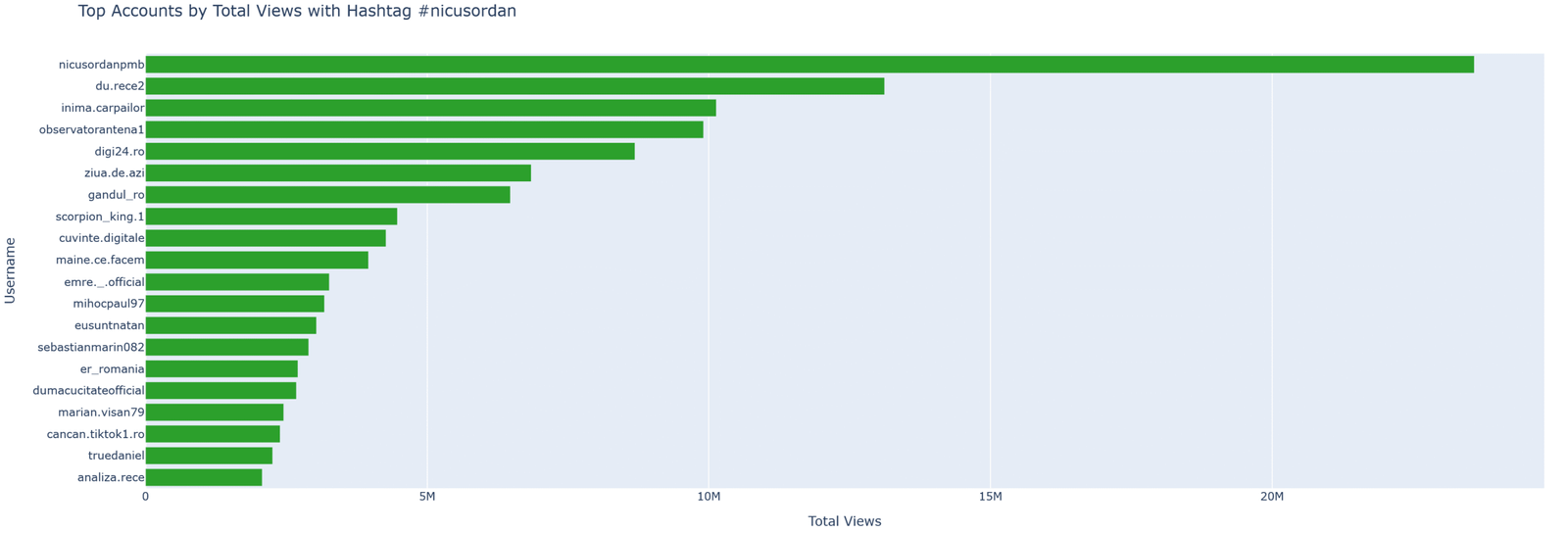
For the hashtag #nicusordan, 11569 videos were collected during the study period, which is substantially less than for #georgesimion. This could indicate either less activity of Dan’s team on TikTok or better quality but less frequent content. The graph of the top 30 accounts by views shows that the leaders are nicusorpentrup and ct.un.muntz, which significantly outpace other channels. Notably, there is a more even distribution of views among the rest of the accounts, which may indicate more natural content distribution. Unlike Simion’s campaign, there is no such bright domination of the candidate’s official account, which indicates a more decentralized strategy or less effective use of official channels.
Top 30 accounts with maximum posts:

Analysis of the top 30 accounts by number of posts for #nicusordan shows a substantial difference from Simion’s campaign. The leader is detectordeminciuni.ro with a record 460 videos, which is almost twice as many as Simion’s most active account. Interestingly, this account, judging by its name, specializes in fact-checking, which may indicate a strategy aimed at debunking competitors’ unreliable information. It is followed by several accounts with roughly equal numbers of publications (80-90 videos), indicating a more even distribution of content creation efforts. Such a structure may indicate a more professional approach to the information campaign, with an emphasis on quality and reliability of content.
Views to likes ratio for top accounts:

/* The dot size depends on the number of posts.
The views to likes ratio graph for top #nicusordan accounts shows a more natural distribution than Simion’s. Nevertheless, an anomalous outlier is observed — the nicusorpentrup account demonstrates a disproportionately high number of likes relative to views, which may indicate artificial engagement enhancement. Most other accounts are in a more typical TikTok range of ratios. The dot sizes (reflecting the number of posts) are also more uniform, confirming the more decentralized nature of Dan’s campaign. Fewer outliers may indicate more organic audience interaction with content and less use of artificial metrics enhancement methods.
Accounts with potentially inflated likes (high likes/views ratio):

The diagram of accounts with potentially inflated likes for #nicusordan reveals anomalies, but on a smaller scale than Simion’s. The maximum likes to views ratio reaches approximately 0.25 (25%), which, although exceeding typical values, is not as extreme as the competitor’s. Most accounts in this list demonstrate indicators in the range of 0.15-0.2, which is at the border of suspicious values. This may indicate less aggressive use of artificial metrics enhancement methods or their more careful masking. Overall, Dan’s campaign appears more organic in terms of audience engagement, although signs of manipulation are also present.
Intersection of videos, authors, hashtags

Analysis of the intersection of videos, authors, and hashtags demonstrates interesting relationships between candidates’ campaigns. The Venn diagram shows that of the total number of videos (by URL), a significant part — 5143 videos — mentions both candidates, which is approximately 30% of all content. This indicates a high level of competitive positioning, where candidates are often mentioned together in the context of comparison or juxtaposition. Even more revealing is the hashtag intersection diagram, where 5306 hashtags are used in the content of both candidates, which indicates competition for the same thematic niches and audience. Such significant intersection may be both a result of natural competition for voters’ attention and a consequence of a purposeful strategy to intercept the competitor’s audience.
Hashtags:

Hashtag clouds for both candidates clearly demonstrate differences in their positioning. Nicusor Dan is dominated by hashtags #alegeri (elections), #romania, #fyp, with a notable presence of #democratie (democracy) and tags related to urban themes. This reflects his image as a reformist, pro-Western candidate, emphasizing democratic values and urban governance. For George Simion, central are #calingeorgescu (connection to the previous candidate), #romania, #fyp, #respect, and hashtags related to nationalism and patriotism are also noticeable. In common hashtags, #romania, #alegerprezidentiale, and #diaspora dominate, indicating the importance of Romanian identity and foreign diaspora themes for both campaigns. These differences highlight the contrasting political positions of the candidates — more pragmatic-reformist for Dan and national-patriotic for Simion.
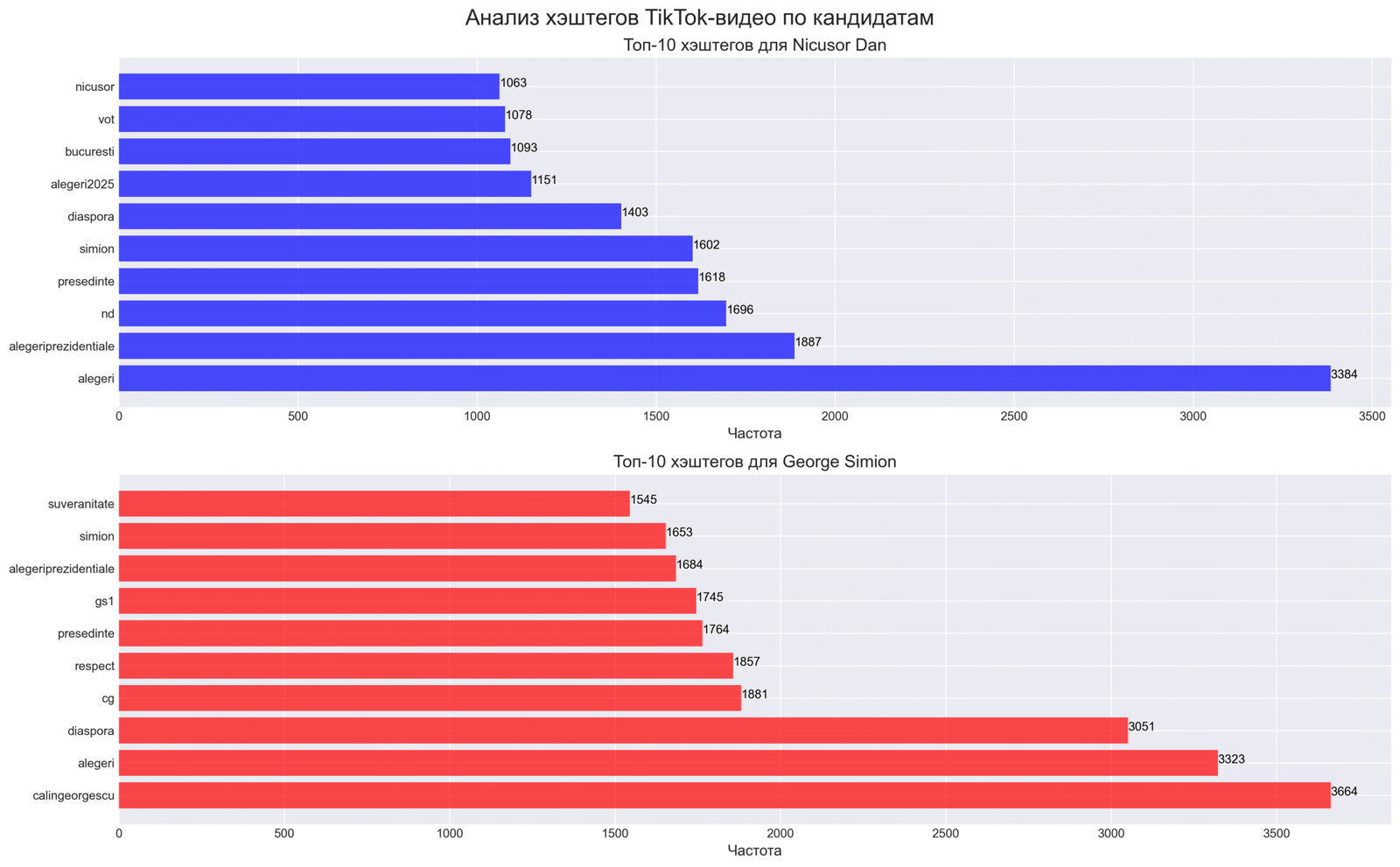
Hashtag clouds for candidates, presented in identical format, allow direct visual comparison of their thematic priorities. For both candidates, national themes (#romania) take central place, but there are substantial differences in emphasis. Dan is more characterized by hashtags related to the election process, reforms, and European integration, while for Simion — hashtags appealing to national identity, patriotism, and connection to the previous candidate Georgescu. The common hashtag cloud shows that despite different political positions, candidates compete for similar audiences, using common themes #romania, #presedinte, #fyp, and #diaspora. This confirms that TikTok has become an important platform for addressing young voters and foreign diaspora during this election campaign.

The second comparison of hashtag clouds is presented in a more detailed format, allowing us to notice additional nuances in candidates’ strategies. Nicusor Dan has more pronounced themes of #democrație (democracy), #usr (party), and #bucuresti (Bucharest), which corresponds to his image as the acting mayor of the capital and representative of reformist forces. Simion noticeably has hashtags #libertate (freedom), #suveranitate (sovereignty), and #foryou, reflecting his national-conservative position and more active use of TikTok’s algorithmic features for promotion. In the common cloud, the most noticeable are nationwide themes and hashtags related to elections, confirming that both campaigns, despite ideological differences, seek to attract voters’ attention through similar thematic blocks, adapting them to their audience.
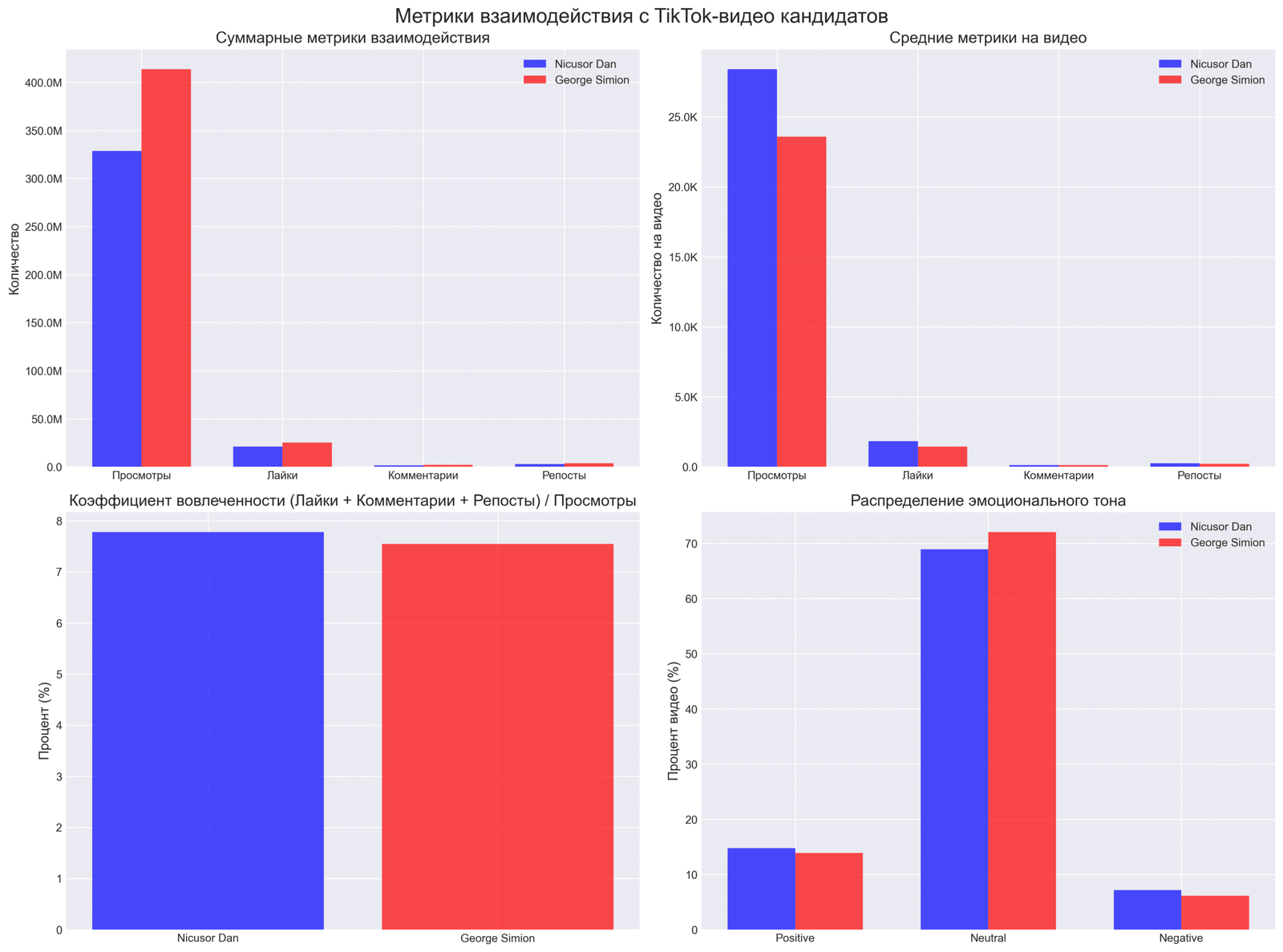
Graphs of engagement metrics with candidates’ TikTok videos demonstrate significant differences and similarities. Summary metrics show that Simion has more total views (about 400 million versus 320 million for Dan), as well as more likes and comments. However, average metrics per video show the opposite picture: Dan has on average more views per video (approximately 25 thousand versus 23 thousand). The engagement coefficient (likes+comments+reposts/views) is almost identical for both candidates, at about 7.5%, indicating a similar level of content resonance with the audience. The distribution of emotional tone is also similar: both are dominated by neutral content (about 70%), followed by positive (about 15%) and negative (7-8%). This indicates similar approaches to content creation, despite different political positions.
Next, let’s examine the personal TikTok accounts of both candidates.
Official Nicusor Dan account:

Detailed analysis of Nicusor Dan’s official account shows moderately successful metrics: 357.6K followers, 8.0M likes, and 401 videos. The total number of views is 126.4M, giving an average of 309.8K views per video. The average engagement of the account is 7.2%, which is a good indicator. Interestingly, the account performance index graph shows steady growth during the last month of the campaign, with several notable activity peaks. These data indicate the candidate’s team’s methodical work with social networks and gradual increase in presence, which is typical for a more “classic” approach to digital campaigning, characteristic of centrist candidates.
Basic socio-demographic characteristics of followers:

Socio-demographic characteristics of Nicusor Dan’s followers demonstrate significant gender imbalance: 67% men versus 33% women. Age distribution shows predominance of young audience: 47% are in the 20-29 age group, followed by the 30-39 age group (34%). Geographic distribution confirms strong concentration of audience in Romania (85%), with small groups in the UK (4%), Germany (3%), and Italy (2%). Such audience structure is characteristic of a pro-Western, reformist candidate oriented towards educated urban youth and middle class. The significant predominance of male audience may be explained both by the specifics of political content and the specifics of TikTok platform algorithms, which may distribute political content differently among users of different genders.
Official George Simion account

Analysis of George Simion’s official account reveals impressive indicators: 1.7M followers, 36.8M likes, and 1.2K videos. The total number of views is a colossal 602.6M, with an average of 488.3K views per video. The average engagement is 6.8%, which is slightly lower than Dan’s, but still a high indicator. The account performance index graph demonstrates a sharper increase in recent months, with a noticeable jump in the last month of the campaign. These data indicate a more aggressive and large-scale social media strategy, characteristic of populist candidates focusing on maximum content distribution and rapid audience growth. Simion’s substantial superiority over Dan in all absolute indicators speaks to the greater priority his team gave to TikTok as a communication channel.
Basic socio-demographic characteristics of followers:
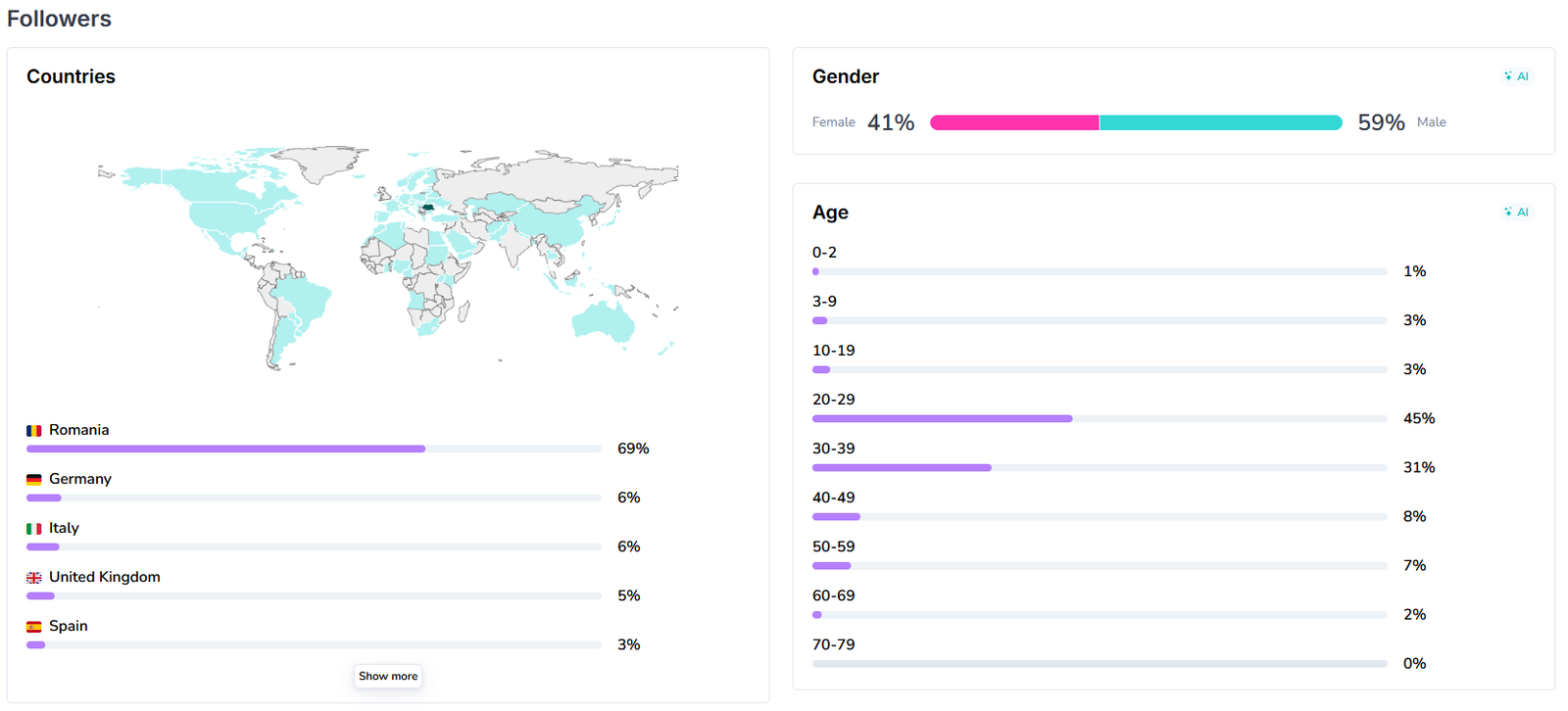
Socio-demographic characteristics of George Simion’s followers also show gender imbalance, but less pronounced: 59% men versus 41% women. The age structure of the audience is somewhat younger than Dan’s: the 20-29 age group makes up 45%, and 30-39 years — 31%. Geographic distribution shows less concentration in Romania (69%) and a larger share of diaspora: Germany (8%), Italy (6%), UK (5%), and Spain (3%). Such audience structure is typical for a national-populist candidate appealing to patriotic feelings and traditional values, especially among youth and diaspora. More balanced gender distribution may indicate more universal appeal of content, and broader diaspora coverage confirms the effectiveness of his strategy for working with overseas Romanians, who often hold more conservative views.
Analysis of strategies and content in the second round
After the first round on May 4, when Simion received almost twice as many votes as Dan, the TikTok campaign became even more intense. For the period from May 4 to May 18, Simion continued to lead in the number of videos, but Dan significantly increased his activity, especially in the last week, when the number of his videos increased by 97%.
Simion’s strategy was to promote narratives about “election fraud” and “external interference,” which is characteristic of disinformation operations (FIMI/DIMI). He actively used emotional mobilization through religious and nationalistic codes, as well as delegitimization of institutions.
Dan, in contrast, focused on themes of democracy, European integration, and the need to fight corruption. His content more often mentioned elections and voting, emphasizing the importance of voter turnout, which ultimately played a decisive role in his victory with a record turnout in the last 25 years.
Conclusions and recommendations
Despite Simion’s superiority in the number of videos and followers, Dan’s victory shows that the quality of content and its relevance to the audience is more important than quantitative indicators. Dan’s campaign, initially lagging in many metrics, managed to mobilize voters at the crucial moment, especially in urban areas and among youth.
For future political campaigns in social networks, it is recommended:
- To focus on creating quality and relevant content, even if this means fewer publications.
- To consider the growing audience engagement in the last weeks before elections and adapt content strategy accordingly.
- To use a variety of video formats of different lengths to reach different audience segments.
- To pay special attention to account verification as a tool to increase campaign credibility.
- To actively combat disinformation narratives and fakes, which are especially spread in the last days before voting.
The experience of the 2025 presidential elections in Romania demonstrates that TikTok has become a critically important platform for political campaigns, but victory in digital space does not always translate into victory in elections if the content does not resonate with the real values and aspirations of voters. The victory of pro-European candidate Nicusor Dan over nationalist George Simion, despite the latter’s advantage in TikTok metrics, is a vivid example of how a quality digital strategy can overcome quantitative superiority.
This publication was developed by a research team under the leadership of Mikhail Doroshevich, PhD.






